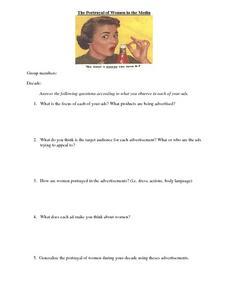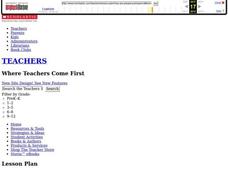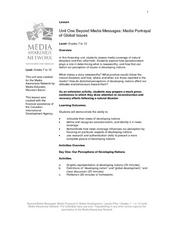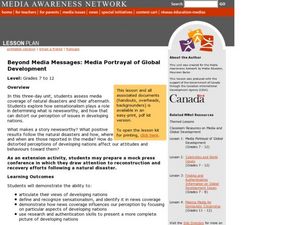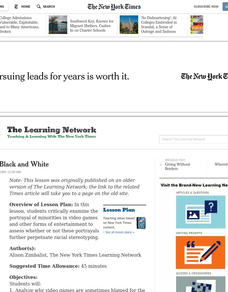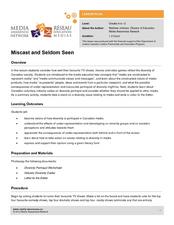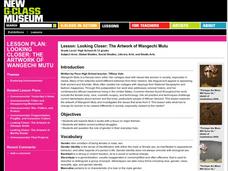Curated OER
The Portrayal of Women in Media
This is an awesome exercise. Learners use this worksheet as they examine an advertisement from a past decade (you need to provide). They answer five questions that aid them in analyzing the ad and the portrayal of women from that time...
Curated OER
How are People Portrayed by Different Media?
Your 9th - 12th graders can hone their analysis and critical thinking skills by studying the way a subject is portrayed across media types. They examine how various print, visual, and online sources have portrayed key players in the 9/11...
Media Smarts
TV Dads: Immature and Irresponsible?
Examine gender stereotypes on television, focusing on fathers portrayed in sitcoms and advertising. Questions on a handout direct learners to consider the types of fathers they see on television and one advertisement is highlighted as...
Curated OER
The Portrayal of the Witches
Eleventh graders discover the importance of the fortune teller in Shakespeare's Macbeth. After watching two interpretations of the play, they examine and compare the portrayal of the character. They create their own modern adaptation of...
Curated OER
Vibrant Animals: Using an Actor's Body for Character Attributes
Students identify and portray specific character attributes through uprigth movement, creating a portrayal of an animal. They use vibrant, upright movement to convey the characteristics and temperament of specific animals. Finally,...
Curated OER
Beyond Media Messages: Media Portrayal of Global Issues
Take a close look at news reporting techniques and global issues. Begin by creating a graphic representation of developing nations and defining the term. After class discussion, the second day's activities pick up by deconstructing news...
Newseum
The Press and the Presidency: Friend or Foe? How the President Is Portrayed
In theory, news reports should be fair and unbiased. Young journalists test this theory by selecting a current news story covered by various media outlets about the President of the United States. They then locate and analyze five...
Curated OER
The Changing Experience of Colonial Childhood
Students research how childhood was depicted in art in the 17th through 19th centuries. In groups, they research pieces of art and write a paper explaining how the portrayal of students in art changed at the end of the 18th century.
Minnesota State University
Media Portrayal of the Vietnam War
History classes can explore two different depictions of the Vietnam War experience with this engaging resource. While watching clips of Platoon and reading excerpts from the comic, The 'Nam, students take notes for use in completing a...
EngageNY
Mid-Unit Assessment: Small Group Discussion: How Do Modern Poems Portray Modern Adversities?
How is a poem similar to and different from a news article? Pupils use a graphic organizer to compare and contrast the two genres. Also, as part of a mid-unit assessment, scholars participate in small-group discussions based on poetry...
Curated OER
A Christmas Carol - Charles Dickens
Young scholars study and explore the portrayal and development of a major character in a novel from the novel, "A Christmas Carol," by Charles Dickens. They identify words and phrases that effectively describe the main character in this...
Curated OER
Beyond Media Messages: Media Portrayal of Global Development
Students discuss global development and create a graphic representation of the discussion. In this media analysis lesson, students deconstruct disaster coverage by reading articles and identifying missing information. Students research...
Curated OER
What a Character! Comparing Literary Adaptations
What do Robert Downey Jr., Basil Rathbone, Jeremy Brett, Fritz Weaver, Roger Moore, Benedict Cumberbatch, and Daffy Duck have in common? Why, it’s elementary, my dear Watson! They all have portrayed Sherlock Holmes. Literary detectives...
Curated OER
Beyond Black and White
Students critically examine the portrayal of minorities in video games and other forms of entertainment and assess the role of racial stereotyping. They keep a log of media minority portrayals and respond to their findings.
Curated OER
Miscast and Seldom Seen
Consider how well students' favorite TV shows, movies and video games reflect the diversity of society. The instructional activity introduces your class to several media literacy concepts, such as how media conveys values and messages,...
Curated OER
Character Attributes in Writing
Third graders analyze the importance of characters in fiction writing and performances. For this theatre lesson, 3rd graders identify the important characteristics of a fictional character and how to portray a character through many...
Media Literacy
Good Versus Evil: Exploring Popular Children's Animation
Dora, Buzz Lightyear, Mufasa. Swiper, Dr. Porkchop, Scar. The six lessons in this unit packet focus on how good and evil, and violence, are portrayed in children's animation. The lessons encourage kids to consider how violence is...
Curated OER
Neighborhood or Slum? Snapshots of Five Points: 1827-1867
How has your local neighborhood changed throughout recent history? Young researchers evaluate census data, images, and primary source descriptions describing the living situation in the antebellum Five Points neighborhood. They consider...
Shakespeare Uncovered
Women’s Roles in As You Like It
“There is nothing that becommeth a maid better than soberness, silence, shamefastness, and chastity, both of body & mind.” This line, from Thomas Bentley ‘s The Monument of Matrons published in 1582, typifies the way women were...
Center Science Education
Weather in the News
Tornadoes, blizzards, and hurricanes, oh my! In this lesson, meteorology majors compare stories of historical storms written by two or more different sources. As a result, they understand how the media portrays such catastrophes and...
Columbus City Schools
Cell-abrate!
Lights, camera, action! With the cell at center stage, guide your seventh grade biologists through the tiny drama that plays out within every living thing. Then, enjoy the show as they portray the organelles they've studied—a performance...
Curated OER
Finding out about Gallery 33
While these worksheets are specific for use while visiting the Birmingham Museum and Art Gallery, they could be used to guide nearly any museum trip. Questions focus on human activity, symbolism, culture, religion, and society as they...
Curated OER
Lesson: Looking Closer: The Artwork of Wangechi Mutu
Social issues of gender and media stereotypes, begins with a multi-sensory experience. Learners view the painting Backlash Blues and make critical comments based on what they see. They then read the Langston Hughes poem and listen to the...
Historical Thinking Matters
Spanish-American War: 1 Day Lesson
After analyzing newspaper articles portraying different perspectives of the explosion of the Battleship USS Maine, your young historians will take a stand on which position is the most believable in both discussion and writing.
Other popular searches
- Character Portrayal
- Media Portrayals of Countries
- Media Portrayal of Wolves
- Media Portrayal
- Speech Portrayal
- Media Portrayals of People
- Different Portrayals of Art
- Media Portrayal of Youth


